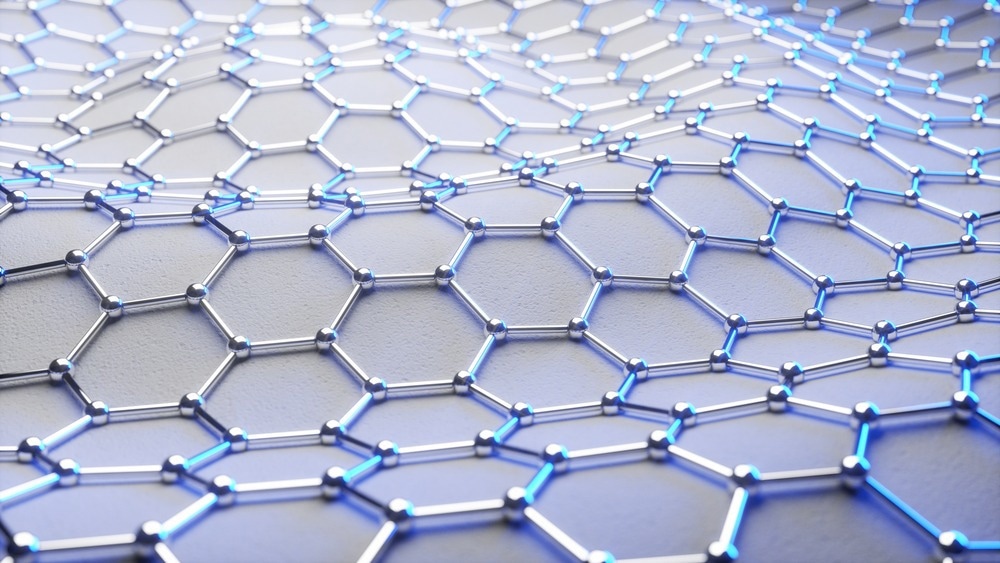Magic-angle twisted bilayer graphene has been recently discovered to exhibit superconductivity, which has inspired theoretical studies on integer fillings. However, studies of fractional filling are sparse.

Study: Fractional correlated insulating states at one-third filled magic angle twisted bilayer graphene. Image Credit: OliveTree/Shutterstock.com
An article published in Communications Physics presented the “fractional correlated insulator” state of the Wannier orbital’s three-peak structure that emerged at fractional filling (ν) of n ± 1/3 (with n integer). This study showed that the filling of one-third (1/3) electrons in each moiré unit cell resulted in short-range interactions leading to an increased entropy because of “breathing” degree of freedom owing to the irregularity in lattice induced by defect lines.
Furthermore, strongly interacting electrons lifted the degeneracy and selected the ferromagnetic nematic state, breaking AB/BA sublattice symmetry. Thus, the suggested fractional correlated insulating state proposed in the present work might suppress the superconductivity at ν = 2 − 1/3 filling.
Magic-Angle Twisted Bilayer Graphene and its Superconductivity
Twisted bilayer graphene is fabricated by the stacking of two monolayers of graphene with a specific twisting angle (θ). In this structure, the moiré pattern has been observed to emerge with a higher periodicity.
Recently, the twisted bilayer graphene has been often reported with extraordinary optical and electronic properties, which were a result of the development of the moiré patterns. The strong electron interactions in the minibands formed in the moiré superlattices of twisted bilayer graphene make them a fascinating platform for studying strongly correlated states.
In most systems, correlated states appear when the moiré lattice is filled with an integer number of electrons per moiré unit cell. The experimental findings on orbital ferromagnetism, other isospin polarizations, and nematic tendencies have led to significant advancements.
However, studies of fractional filling were less explored, even though phase diagrams revealed potentially complex phenomena at partial fills, such as the suppression of superconductivity close to the filling of v = 2-1/3.
From the theoretical point of view, interest in integer filling originates from the complexity of magic-angle-twisted bilayer graphene. Additionally, the experimental findings reveal that magic-angle twisted bilayer graphene exhibits a triangular superlattice centered on Wannier orbitals, which are obstructed by the topology and symmetry of the Bloch wave functions.
Alternatively, the three lobes of the wavefunction extend to the three nearby AA sites, and the Wannier orbitals are centered at the AB or BA sites. Such extended Wannier orbitals make it difficult to create a local model because they require the inclusion of interactions and further-range hopping elements.
One-Third Filled Magic Angle Twisted Bilayer Graphene
Previous researchers discovered a drop in the superconducting conductivity at ν = 2 − 1/3, which was inspired by the dip in superconductivity in cuprates at a commensurate partial filling of 1/8 holes per plane of copper oxide. This decrease in superconductivity causes the system to insulate even at the lowest temperatures.
The present study focused on the effects of Wannier orbitals and Wannier obstruction in magic-angle-twisted bilayer graphene at ν = 1/3 electrons per unit cell. The strong-coupling limit allowed the mapping of the present problem to the tiling issue.
This mapping helped assert the extensive degeneracy of the ground state at ν of 1/3, which was confined to short-range interactions. The Monte Carlo simulation helped to identify several ground states at low temperatures in the no-touching model, which was consistent with the predicted extensive degeneracy.
In contrast to krypton adsorbed on graphite, the "no-touching" model limited to local interactions had a zero Hamiltonian because the flip lines and Y-junctions used no energy. A long-range density-density Coulomb interaction would not disrupt the degeneracy because it consists of states with the same uniform charge density but different Wannier state layouts.
Conclusion
In summary, the present work revealed a translationally symmetric fractional correlated insulating state mechanism in magic-angle twisted bilayer graphene. The significant effect of the Wannier obstruction in magic-angle twisted graphene was due to the incompressibility of the n ± 1/3 states.
The shortest interaction encouraged a uniform charge distribution, where one-third of the charge was concentrated at each AA site, with the weight of the Wannier orbitals divided into three lobes, resulting in the fractional filling.
This study demonstrated that the short-range no-touching restriction alone would imply extensive entropy by linking the model to the trimer-tiling issue. The ferromagnetic arrangement was favored by further-range interactions, equivalent to direct exchange.
Direct exchange increased degeneracy and selected a complicated state that destroyed the AB/BA sublattice symmetry and C3 rotational symmetry. In addition to the spin ferromagnetic arrangement, the twisted bilayer graphene featured an antiferromagnetic arrangement of the AB/BA Wannier centers. Thus, this study focused on exchange interactions and hopping as disturbances to obtain results on degeneracy splitting.
Reference
Zhang, K., Zhang, Y., Fu, L., Kim, E-A. (2022). Fractional correlated insulating states at one-third filled magic angle twisted bilayer graphene. Communications Physics. https://www.nature.com/articles/s42005-022-01027-6#Abs1
Disclaimer: The views expressed here are those of the author expressed in their private capacity and do not necessarily represent the views of AZoM.com Limited T/A AZoNetwork the owner and operator of this website. This disclaimer forms part of the Terms and conditions of use of this website.